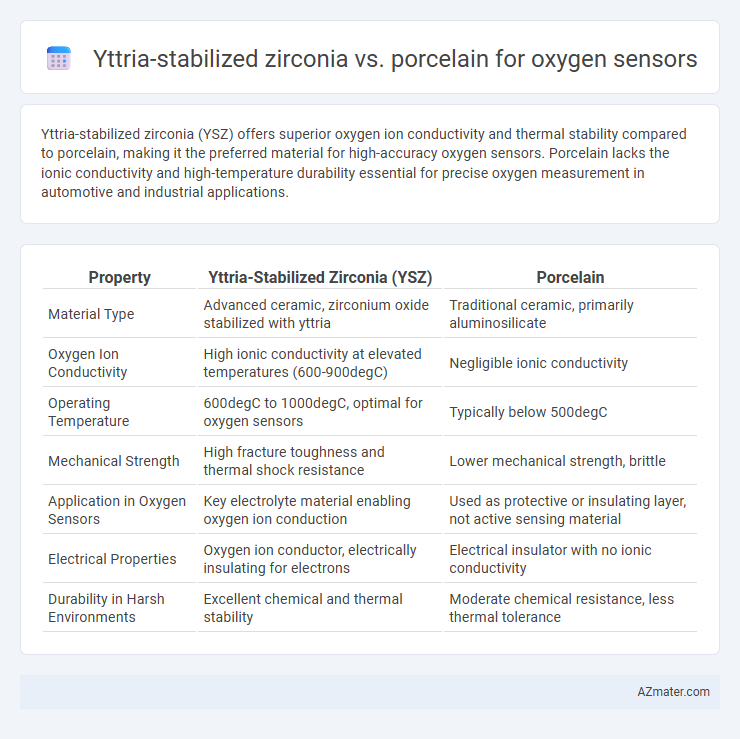Yttria-stabilized zirconia (YSZ) offers superior oxygen ion conductivity and thermal stability compared to porcelain, making it the preferred material for high-accuracy oxygen sensors. Porcelain lacks the ionic conductivity and high-temperature durability essential for precise oxygen measurement in automotive and industrial applications.
Table of Comparison
| Property | Yttria-Stabilized Zirconia (YSZ) | Porcelain |
|---|---|---|
| Material Type | Advanced ceramic, zirconium oxide stabilized with yttria | Traditional ceramic, primarily aluminosilicate |
| Oxygen Ion Conductivity | High ionic conductivity at elevated temperatures (600-900degC) | Negligible ionic conductivity |
| Operating Temperature | 600degC to 1000degC, optimal for oxygen sensors | Typically below 500degC |
| Mechanical Strength | High fracture toughness and thermal shock resistance | Lower mechanical strength, brittle |
| Application in Oxygen Sensors | Key electrolyte material enabling oxygen ion conduction | Used as protective or insulating layer, not active sensing material |
| Electrical Properties | Oxygen ion conductor, electrically insulating for electrons | Electrical insulator with no ionic conductivity |
| Durability in Harsh Environments | Excellent chemical and thermal stability | Moderate chemical resistance, less thermal tolerance |
Introduction to Oxygen Sensor Materials
Yttria-stabilized zirconia (YSZ) is a widely used material in oxygen sensors due to its excellent ionic conductivity and durability at high temperatures, enabling accurate oxygen partial pressure measurements in harsh environments. Porcelain, while offering good mechanical strength and thermal stability, lacks the ionic conduction properties essential for efficient sensor performance. The selection between YSZ and porcelain hinges on the sensor's functional requirements, with YSZ being the preferred electrolyte material for electrochemical oxygen sensors.
Overview of Yttria-Stabilized Zirconia (YSZ)
Yttria-stabilized zirconia (YSZ) is a ceramic material widely used in oxygen sensors due to its high ionic conductivity and thermal stability at elevated temperatures. Its crystal structure is stabilized by yttria (Y2O3), which enhances oxygen ion mobility, making it ideal for accurate and rapid oxygen concentration measurements in automotive and industrial applications. Unlike porcelain, YSZ exhibits superior mechanical strength and chemical resistance, ensuring prolonged sensor durability and reliable performance.
Properties of Porcelain in Sensor Applications
Porcelain in oxygen sensors offers excellent electrical insulation and high thermal stability, making it suitable for harsh operating environments. Its low thermal conductivity helps maintain sensor temperature, ensuring accurate oxygen measurements. However, porcelain's brittleness and lower oxygen ion conductivity compared to yttria-stabilized zirconia limit its use as an electrolyte but remain valuable as a protective, insulating component in sensor assemblies.
Ion Conductivity: YSZ vs Porcelain
Yttria-stabilized zirconia (YSZ) exhibits significantly higher oxygen ion conductivity compared to porcelain, making it the preferred material for oxygen sensors. The stabilized zirconia lattice in YSZ enables efficient oxygen ion transport at elevated temperatures, essential for accurate gas composition measurements. Porcelain, being a ceramic with lower ionic mobility, lacks the necessary ion conductivity to function effectively in high-temperature oxygen sensing applications.
Thermal Stability and Resistance
Yttria-stabilized zirconia (YSZ) exhibits superior thermal stability and resistance compared to porcelain in oxygen sensors, maintaining structural integrity at temperatures exceeding 1000degC. Its ionic conductivity allows precise oxygen ion transport essential for accurate sensor readings, while porcelain often degrades or loses functionality under high thermal stress. The robust thermal shock resistance of YSZ enhances the sensor's durability and lifespan in harsh automotive and industrial environments.
Mechanical Strength and Durability Comparison
Yttria-stabilized zirconia (YSZ) offers superior mechanical strength compared to porcelain, with its toughness reaching approximately 1000 MPa versus porcelain's 300-500 MPa, making it more resistant to cracking under thermal stress. YSZ's high fracture toughness of about 10 MPa*m^0.5 enhances durability and lifespan in harsh, high-temperature environments typical of oxygen sensor operation. Porcelain, while electrically insulating and thermally stable, lacks the mechanical robustness and thermal shock resistance found in yttria-stabilized zirconia, leading to shorter sensor service life and higher failure rates under extreme conditions.
Manufacturing Processes and Scalability
Yttria-stabilized zirconia (YSZ) is manufactured using powder processing techniques such as tape casting, pressing, and sintering, enabling precise control over microstructure and ionic conductivity for oxygen sensors. Porcelain, made from clay-based materials through molding and firing processes, offers simpler production but lacks the ionic conductivity needed for high-performance sensors. The scalability of YSZ production benefits from advanced ceramic manufacturing technologies, supporting high-volume, consistent sensor fabrication, whereas porcelain's scalability is limited by its lower functional performance and less specialized production methods.
Sensor Performance: Sensitivity and Accuracy
Yttria-stabilized zirconia (YSZ) exhibits superior oxygen sensor performance due to its high ionic conductivity and thermal stability, enabling precise detection of oxygen partial pressure in harsh environments. Porcelain, often used as a protective layer or substrate, lacks the intrinsic electrochemical properties necessary for accurate oxygen sensing but provides mechanical support and chemical resistance. The sensitivity and accuracy of oxygen sensors are primarily determined by the YSZ electrolyte's ability to generate a measurable voltage corresponding to oxygen concentration, making it the preferred material over porcelain for sensor performance.
Cost Analysis: YSZ vs Porcelain
Yttria-stabilized zirconia (YSZ) offers superior durability and oxygen ion conductivity compared to porcelain, resulting in longer sensor lifespan and reduced maintenance costs. Although the initial investment for YSZ-based oxygen sensors is higher than porcelain, their enhanced performance and reliability lead to lower total cost of ownership over time. Porcelain sensors, while cheaper upfront, often require more frequent replacements and exhibit less stability under high-temperature conditions, increasing operational expenses.
Industry Applications and Future Trends
Yttria-stabilized zirconia (YSZ) is widely used in oxygen sensors due to its high ionic conductivity and thermal stability, making it ideal for automotive exhaust systems and industrial combustion monitoring. Porcelain, while inexpensive and electrically insulating, lacks the durability and sensitivity required for precise oxygen measurement in harsh industrial environments. Future trends focus on enhancing YSZ with dopants for improved performance and integrating it with smart sensor technologies to enable real-time data analytics in manufacturing and environmental applications.

Infographic: Yttria-stabilized zirconia vs Porcelain for Oxygen Sensor
 azmater.com
azmater.com